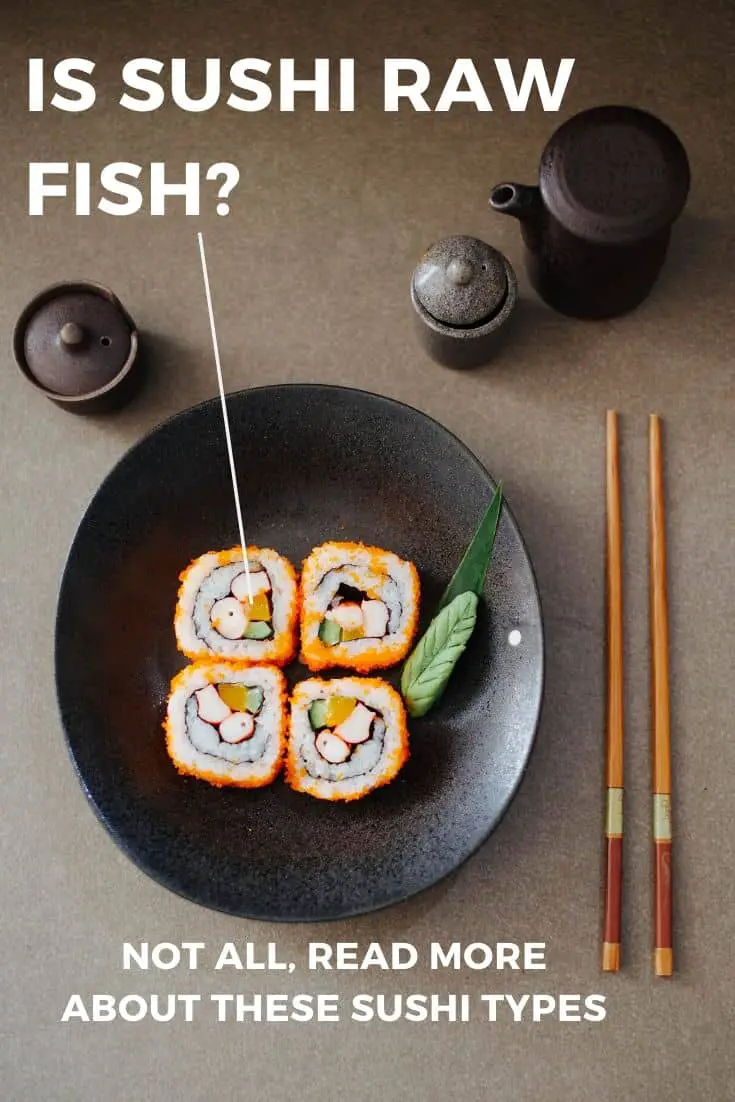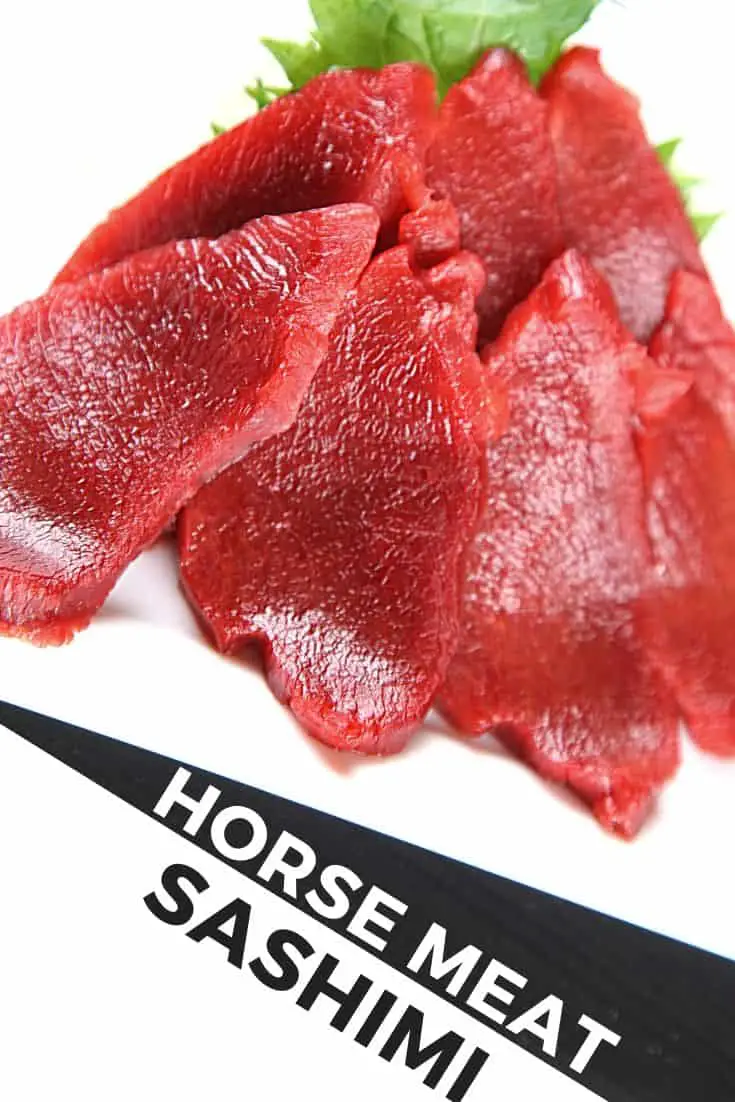Is sushi raw fish? Not always! Here are the different types out there
Although sushi isn’t originally from Japan, it’s traditional and the most liked Japanese dish. It has historic importance since it dates back hundreds of years.
Today, this dish is available in multiple flavors and shapes. It’s prepared using steamed rice, vinegar, sugar, salt, seafood, vegetables, and sometimes, tropical food. The vinegared rice and seaweed are wrapped around other vegetables and seafood ingredients, making a delicious bundle!

Because of its special preparation techniques, this method is mastered only by native Japanese and expert cooks.
Also, the ingredients play a key role. So a perfect ensemble of everything is required for a delicious and authentic taste.
But the question that a lot of you have (especially if you’re new to Japanese food) is this: Is sushi raw fish?
When you refer to the raw fish you can get at sushi restaurants, you mean “sashimi”. Although a lot of sushi types have raw fish in them, sushi can also have vegetables or even meat. Sashimi is slices of raw fish.
“Sashimi” is a Japanese term that translates to “pierced body”. Sashimi is bite-sized sliced fish or meat that’s used in sushi, as well as several other dishes.
In this post we'll cover:
Can sashimi be meat?
Sashimi refers to the way fish or meat is cut into thin slices. Although sashimi in America is almost always fish, it can be meat as well! It’s always raw and consumed with sauces such as soy sauce, wasabi, etc.

Commonly, sashimi includes salmon or tuna, but other raw seafood is also eaten doesn’t involve any complex processing.
Sashimi seafood includes:
- Squid
- Shrimp
- Sea urchin
- Yellowtail
- Octopus (cooked)
- Mackerel
- Scallop
Although it isn’t conventional to name pieces of fruit and vegetables as sashimi, the Japanese enjoy fresh fruits and vegetables served with sauces, which they also consider sashimi. The thin slices of fruit even resemble the skin of fish!
The vegetable and fruity sashimi include:
- Avocado
- Takenoko
- Radish
Sashimi slices are taken as a side dish. However, together with sushi, miso soup, and rice, they’re enjoyed as a full-course meal.
What are sashimi slices?
Sashimi pieces are sliced in a specific manner. To make them bite-sized, they’re cut neither too thin nor too big.
The fish meat is divided into pieces in a direction that’s across the spine and against the grain. In this way, the chef can make sure the sashimi isn’t lumpy. This technique is only possible using a sharp knife.
I have a full article on sushi knives here if you’d like to learn more about the types of sharp knives sushi chefs like to use.
There are even reviews of some you can get yourself if you’d like to get started with Japanese cuisine!

Check out our new cookbook
Bitemybun's family recipes with complete meal planner and recipe guide.
Try it out for free with Kindle Unlimited:
Read for freeTypes of sushi
Sushi is available in many types because it originated from multiple places.
Although the basic ingredient of sushi (i.e. vinegared rice) is the same in all sushi, it differs because of toppings, fillings, sauces, condiments, etc.
Here are a few general types of sushi.
Chirashizushi
This is also referred to as “barazushi” and is the simplest form of sushi. It’s very convenient and easy to make because it includes no preparation of sushi rolls.
Generally, raw or cooked fish, seafood, vegetables, and other ingredients are served in a donburi bowl full of rice.
Chirashizushi is famous because of the ease and aesthetic arrangement of toppings on top of the rice.
Makizushi
Makizushi is the cylindrical-shaped sushi usually seen in pictures and videos. It consists of sushi rice wrapped in seaweed, soy paper, or a thin omelet layer.
The chopped tuna or whitefish flakes act as the topping for this sushi. You can also have a cucumber roll for a vegetarian option.
Inarizushi
This type of sushi is named after the Inari god of Japan. It includes fried tofu in a thin layer of omelet with sharp and crispy edges. The filling contains special sushi rice.
It’s often confused with inari maki, which is the sushi roll. Variations and different styles of inarizushi are commonly seen in Japan since it’s a regional delight.
Oshizushi
This is the special delight of Osaka, having the look of a cake or a pastry. It only contains cooked or processed meat that’s made into bite-sized cubes by a Japanese pressing tool.
The special rice and other ingredients are added to a pot and are pressed with the tool until the flat block shape is achieved. The whole thing is then sliced into small pieces.
Nigirizushi
This is elliptical-shaped sushi made by pressing the rice in the palm. The topping is then attached to the oval-shaped rice by seaweed, nori, or by gentle pressing.
Typically, the topping is seafood, such as octopus, squid, or freshwater eel. The special sauce for this one is wasabi.
Modern narezushi
This is the fermented sushi in which the fish is stuffed with salt to preserve for later use. Usually, the salted fish takes 6 months to dry. After this period, these salted bites are served.
You should read my in-depth article on the different types of sushi here, where I describe these and a lot more types of sushi and explain all the differences between them. I also talk about modern American sushi in that article so you can see the differences in how sushi is served in Japan.
What’s the difference between sushi and sashimi?
Many people often mistake sushi for sashimi, but they’re actually totally different.
The main differences are:
- Sushi is a mixture of multiple ingredients, whereas sashimi is only bite-sized sliced fish.
- Sushi can contain both raw and cooked fish, and seafood. On the other hand, sashimi is only raw fish and meat.
- Sushi is a complete meal, whereas sashimi is just a lump of simple meat as a side serving.
Read more here on all of the differences involved in making sushi and sashimi, and all of their health benefits.
Is there raw fish in sushi itself?
Sushi can contain a lot of different ingredients like meat, vegetables, and cooked fish, but raw fish is definitely the most popular one. Just like any other ingredient, raw fish acts as the filling of sushi. It may or may not be cooked, but the rice should be cooked to hold the roll together.
Many ingredients serve as stuffing and toppings of sushi. Japanese refer to them as “neta”. They can be raw or cooked fish, or any other meat, depending upon the person’s preferences.
Is the fish in sushi always raw?
Although sushi is liked globally, a lot of misconceptions occur from time to time. The most common one is that only raw fish is used in sushi.
The truth is that both raw and cooked slices of fish can be used for sushi.
Raw meat may be a part of the ingredient list of sushi, but it isn’t mandatory. It depends on how a person wants to enjoy it and what you might want to order at a restaurant.
Is there any sushi without raw fish?
It’s sometimes very difficult for beginners to handle raw fish sushi, both taste-wise and cooking-wise. So some of you may dread a trip to a local Japanese restaurant.
So it’s always recommended to start with sushi without any raw fish (or vegetarian sushi without any type of fish or seafood). There are tons of other types of sushi containing no slices of raw fish or sashimi.
A few other flavors of sushi that contain no raw fish are:
- Smoked salmon sushi
- Nigiri (cooked)
- Maki avocado
- Uramaki (cooked)
- Tamaki
- Tropica
- Caterpillar sushi roll
- PLS roll
- Spam musubi sushi
Sushi with raw salmon
The most popular fish used in sushi is salmon. It’s available in all restaurants and sushi food stalls.
The raw pieces of salmon are filled into the moist vinegared rice and enjoyed with soy or wasabi sauce.
One important thing is the freshness and the skin layer of the salmon. It should be frozen before use to have an absolutely fresh taste, or you should eat it fresh off the boat in a harbor town.
Similarly, the way it’s prepared is essential, and the slices should be cut perfectly against the grain.
Sushi with raw shrimp
Sushi with raw shrimp has its own special name called “amaebi”. They have a sweet taste and should only be eaten uncooked to get this delicious flavor.
They’re very small in size, so restaurants usually serve 2 or more in a single serving.
The Japanese usually prefer it only in a special season when female shrimp bear eggs. These eggs add to the taste so it’s best enjoyed in this season if you want to get the real experience.
Just like raw salmon, it should only be eaten when they’re fresh. Edible shrimp are checked according to their color and shape. Pink-colored shrimp with a curly body are considered safe.
Also, the black mark on the head is also examined. If it’s big, the shrimp is stale and best thrown away.
Sushi with raw tuna
Tuna holds traditional value in Japanese sushi. It’s historically the most preferred sushi that’s available in several types. It’s also very expensive and takes a superior place in the Japanese menu.
Since it has different types with special titles, it covers vast variations of sushi flavors, such as:
- Yellowfin
- Skipjack
- Albacore
- Bluefin (“Maguro” in Japanese terms)
Tuna fish meat is further divided into 2 parts based on the content of fat:
- Akami: This is the part of the meat with less fat content. It’s mostly used for making sushi rolls.
- Toro: This is the fatty part of the tuna meat. This fat content is very rare so toro tuna sushi is the most expensive one.
What is the nutritional content of sushi?
Since there are so many categories and numerous ingredients in sushi, it’s not possible to describe them as a whole. However, the ingredients can be quantified separately.
And if you want to know more about the nutrition of different types of sushi, I’ve written about sushi calories for popular rolls here.
The nutritional content of different sushi roles is given below:
- Avocado roll: 140 calories
- California roll: 255 calories
- Shrimp tempura roll: 508 calories
- Yellowtail and scallion roll: 245 calories
- Spicy tuna roll: 290 calories
What is the nutritional content of sashimi?
One piece of sashimi contains around 35 calories. That’s raw fish sashimi.
Eat sushi and sashimi for tasty Japanese cuisine
Now you know that sushi doesn’t always have raw fish. So if eating raw fish isn’t your thing, not to worry, as there are plenty of other tasty cooked fillings you can try for sushi.
Check out our new cookbook
Bitemybun's family recipes with complete meal planner and recipe guide.
Try it out for free with Kindle Unlimited:
Read for freeJoost Nusselder, the founder of Bite My Bun is a content marketer, dad and loves trying out new food with Japanese food at the heart of his passion, and together with his team he's been creating in-depth blog articles since 2016 to help loyal readers with recipes and cooking tips.
